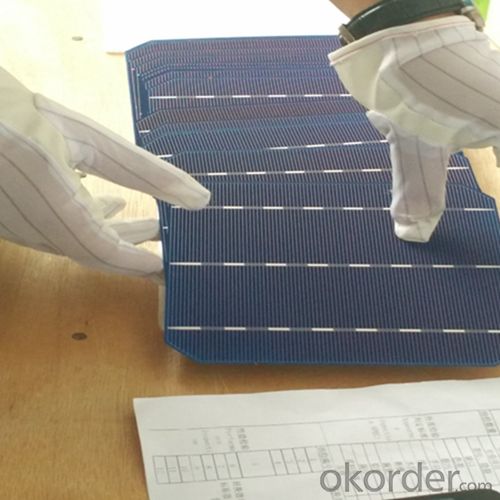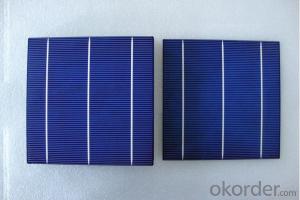Best Solar Cells To Buy:Poly 156x156mm2 Solar Cells Made in Class 1
- Loading Port:
- Shanghai
- Payment Terms:
- TT OR LC
- Min Order Qty:
- 6500 watt
- Supply Capability:
- 6000000 watt/month
OKorder Service Pledge
OKorder Financial Service
You Might Also Like
The operation of a photovoltaic (PV) cell requires 3 basic attributes:
The absorption of light, generating either electron-hole pairs or excitons.
The separation of charge carriers of opposite types.
The separate extraction of those carriers to an external circuit.
In contrast, a solar thermal collector supplies heat by absorbing sunlight, for the purpose of either direct heating or indirect electrical power generation from heat. A "photoelectrolytic cell" (photoelectrochemical cell), on the other hand, refers either to a type of photovoltaic cell (like that developed by Edmond Becquerel and modern dye-sensitized solar cells), or to a device that splits water directly into hydrogen and oxygen using only solar illumination.Characteristic of Mono 156X156MM2 Solar Cells
You are gaining energy independence - add battery backup power for even greater energy security
The cost of electricity is only going to rise – insure against that rising cost
Adaptive cells change their absorption/reflection characteristics depending to respond to environmental conditions. An adaptive material responds to the intensity and angle of incident light. At the part of the cell where the light is most intense, the cell surface changes from reflective to adaptive, allowing the light to penetrate the cell. The other parts of the cell remain reflective increasing the retention of the absorbed light within the cell.[67]
In 2014 a system that combined an adaptive surface with a glass substrate that redirect the absorbed to a light absorber on the edges of the sheet. The system also included an array of fixed lenses/mirrors to concentrate light onto the adaptive surface. As the day continues, the concentrated light moves along the surface of the cell. That surface switches from reflective to adaptive when the light is most concentrated and back to reflective after the light moves along
Mechanical data and design
Format | 156mm x 156mm±0.5mm |
Thickness | 210μm±40μm |
Front(-) | 1.5mm bus bar (silver),blue anti-reflection coating (silicon nitride) |
Back (+) | 2.5mm wide soldering pads (sliver) back surface field (aluminium) |
Temperature Coefficient of Cells
Voc. Temp.coef.%/K | -0.35% |
Isc. Temp.coef .%/K | +0.024%/K |
Pm.Temp.coef. %/K | -0.47%/K |
Electrical Characteristic
Effiency(%) | Pmpp(W) | Umpp(V) | Impp(A) | Uoc(V) | Isc(A) | FF(%) |
18.35 | 4.384 | 0.526 | 8.333 | 0.63 | 8.877 | 78.39% |
18.20 | 4.349 | 0.526 | 8.263 | 0.63 | 8.789 | 78.54% |
18.05 | 4.313 | 0.525 | 8.216 | 0.63 | 8.741 | 78.32% |
17.90 | 4.277 | 0.524 | 8.161 | 0.625 | 8.713 | 78.04% |
17.75 | 4.241 | 0.523 | 8.116 | 0.625 | 8.678 | 77.70% |
17.60 | 4.206 | 0.521 | 8.073 | 0.625 | 8.657 | 77.36% |
17.45 | 4.170 | 0.519 | 8.039 | 0.625 | 8.633 | 76.92% |
17.30 | 4.134 | 0.517 | 8.004 | 0.625 | 8.622 | 76.59% |
17.15 | 4.096 | 0.516 | 7.938 | 0.625 | 8.537 | 76.80% |
17.00 | 4.062 | 0.512 | 7.933 | 0.625 | 8.531 | 76.18% |
16.75 | 4.002 | 0.511 | 7.828 | 0.625 | 8.499 | 75.34% |
16.50 | 3.940 | 0.510 | 7.731 | 0.625 | 8.484 | 74.36% |




 FAQ
FAQ
Q: What price for each watt?
A: It depends on the quantity, delivery date and payment terms, generally Large Quantity and Low Price
Q: What is your size for each module? Can you tell me the Parameter of your module?
A: We have different series of panels in different output, both c-Si and a-Si. Please take the specification sheet for your reference.
Q: What is your size for each module? Can you tell me the Parameter of your module?
A: We have different series of panels in different output, both c-Si and a-Si. Please take the specification sheet for your reference.
- Q: Can solar cells be used for military applications?
- Yes, solar cells can be used for military applications. They can provide a reliable and independent source of power for various military equipment, including remote surveillance systems, communication devices, and even powering military bases or remote outposts. Solar cells offer the advantage of being lightweight, portable, and environmentally friendly, making them suitable for a range of military operations and reducing reliance on traditional fuel sources.
- Q: How do solar cells compare to fossil fuel-based power generation?
- Solar cells are a more sustainable and environmentally friendly alternative to fossil fuel-based power generation. Solar cells harness the power of sunlight, a renewable energy source, to generate electricity, while fossil fuel-based power generation relies on the burning of finite fossil fuels like coal, oil, and gas. Solar cells produce clean energy, emit no greenhouse gases, and have little to no impact on climate change. Additionally, while fossil fuel-based power generation requires constant extraction and transportation of fuels, solar cells can be installed in various locations, making them more versatile and accessible. However, solar cells are currently less efficient and more expensive than fossil fuel-based power generation, which hinders their widespread adoption.
- Q: Can solar cells be used in powering communication networks?
- Yes, solar cells can be used to power communication networks. Solar cells convert sunlight into electricity, providing a reliable and renewable source of power. This makes them suitable for remote areas where traditional power sources may not be available or practical. By harnessing solar energy, communication networks can operate efficiently while reducing reliance on fossil fuels and minimizing their environmental impact.
- Q: How to make solar cells in a scientific way?
- You can ask your teacher and let him show you how to do it.
- Q: Friends are fuel cells are chemical energy into electricity, solar cells are converted into electricity into electricity I would like to know in addition to the structure and the conversion of different ways there are no other differences hope that the specific power of everyone
- In general, the fuel cell has the following characteristics: (1) high energy conversion efficiency He will directly convert the chemical energy of fuel into electricity, the middle without the combustion process, and thus not limited by the Carnot cycle.
- Q: Can solar cells be used in greenhouses?
- Yes, solar cells can be used in greenhouses to generate electricity and power various systems within the greenhouse, such as lighting, ventilation, and irrigation. This helps reduce the reliance on traditional energy sources and promotes sustainable and eco-friendly practices in greenhouse farming.
- Q: How do solar cells perform in dusty environments?
- Solar cells perform less efficiently in dusty environments due to reduced sunlight reaching the surface of the cells. Dust particles can accumulate on the surface of the solar panels, blocking the sunlight and reducing the amount of energy that can be converted. Regular cleaning and maintenance are necessary to ensure optimal performance in dusty conditions.
- Q: Can solar cells be combined with energy storage systems?
- Yes, solar cells can be combined with energy storage systems. This combination allows for the capture and storage of excess solar energy generated during periods of high sunlight, which can then be used during times when solar energy is not available. Energy storage systems help address the intermittent nature of solar power, ensuring a continuous and reliable energy supply.
- Q: I bought a new poly solar cells, and the test result of the conversion efficiency is 16.8%, is it lower than usual?
- It depends on what kind os poly solar cell you are using, if it is 260 watt photovoltaic solar panel, 16.8% is a bit lower.
- Q: Can solar cells be used to power remote sensing devices?
- Yes, solar cells can be used to power remote sensing devices. Solar cells convert sunlight into electricity, providing a reliable and sustainable source of power for remote sensing devices in areas where traditional power sources may be unavailable or impractical. This enables continuous operation of these devices, allowing for data collection and monitoring in remote locations.
Send your message to us
Best Solar Cells To Buy:Poly 156x156mm2 Solar Cells Made in Class 1
- Loading Port:
- Shanghai
- Payment Terms:
- TT OR LC
- Min Order Qty:
- 6500 watt
- Supply Capability:
- 6000000 watt/month
OKorder Service Pledge
OKorder Financial Service
Similar products
Hot products
Hot Searches
Related keywords


























